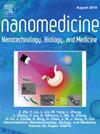Development of nanoparticles and quantum dots as alternatives to iodinated contrast agents for mono-modal and bi-modal computed tomography imaging
IF 4.6
2区 医学
Q2 MEDICINE, RESEARCH & EXPERIMENTAL
Nanomedicine : nanotechnology, biology, and medicine
Pub Date : 2025-06-12
DOI:10.1016/j.nano.2025.102831
引用次数: 0
Abstract
Medical imaging plays a pivotal role in disease screening, early detection, and diagnosis. Among the various imaging modalities, computed tomography (CT) is one of the most widely utilized in clinical practice, offering high-resolution anatomical images critical for disease investigation. To enhance the visibility of tissues with similar densities, contrast agents are often required. Iodinated contrast agents, the most commonly used, are effective but have significant limitations, including short circulation times, the need for high-concentration injections, restricted tissue targeting, and potential side effects such as nephrotoxicity. These challenges have spurred the development of next-generation contrast agents. Nanostructured materials, particularly nanoparticles and quantum dots, have emerged as promising alternatives due to their superior X-ray attenuation, extended circulation times, and potential for multi-modal imaging applications such as CT/MRI and CT/fluorescence. Their unique properties, including small size, large surface area, and tunable functionalization enable targeted imaging and reduced side effects, making them ideal candidates for advanced diagnostics. This review highlights the recent advancements in synthesizing and optimizing nanostructured contrast agents based on their elemental composition, synthesis techniques, and imaging properties. It underscores the transformative potential of nano-based agents in enhancing diagnostic accuracy while minimizing adverse effects, marking a significant step forward in medical imaging technology.
纳米粒子和量子点的发展作为碘造影剂的替代品用于单峰和双峰计算机断层成像。
医学影像在疾病筛查、早期发现和诊断中起着关键作用。在各种成像方式中,计算机断层扫描(CT)是临床实践中应用最广泛的一种,它提供了高分辨率的解剖图像,对疾病调查至关重要。为了增强具有相似密度的组织的可见性,通常需要使用造影剂。碘造影剂,最常用的,是有效的,但有明显的局限性,包括循环时间短,需要高浓度注射,限制组织靶向,以及潜在的副作用,如肾毒性。这些挑战刺激了下一代造影剂的发展。纳米结构材料,特别是纳米颗粒和量子点,由于其优越的x射线衰减,延长的循环时间,以及多模态成像应用(如CT/MRI和CT/荧光)的潜力,已经成为有希望的替代品。其独特的特性,包括小尺寸、大表面积和可调的功能化,可以实现靶向成像和减少副作用,使其成为高级诊断的理想候选者。本文综述了基于纳米结构造影剂的元素组成、合成技术和成像特性的合成和优化纳米结构造影剂的最新进展。它强调了纳米试剂在提高诊断准确性的同时最大限度地减少不良反应方面的变革潜力,标志着医学成像技术向前迈出了重要一步。
本文章由计算机程序翻译,如有差异,请以英文原文为准。
求助全文
约1分钟内获得全文
求助全文
来源期刊
CiteScore
11.10
自引率
0.00%
发文量
133
审稿时长
42 days
期刊介绍:
The mission of Nanomedicine: Nanotechnology, Biology, and Medicine (Nanomedicine: NBM) is to promote the emerging interdisciplinary field of nanomedicine.
Nanomedicine: NBM is an international, peer-reviewed journal presenting novel, significant, and interdisciplinary theoretical and experimental results related to nanoscience and nanotechnology in the life and health sciences. Content includes basic, translational, and clinical research addressing diagnosis, treatment, monitoring, prediction, and prevention of diseases.

 求助内容:
求助内容: 应助结果提醒方式:
应助结果提醒方式:


